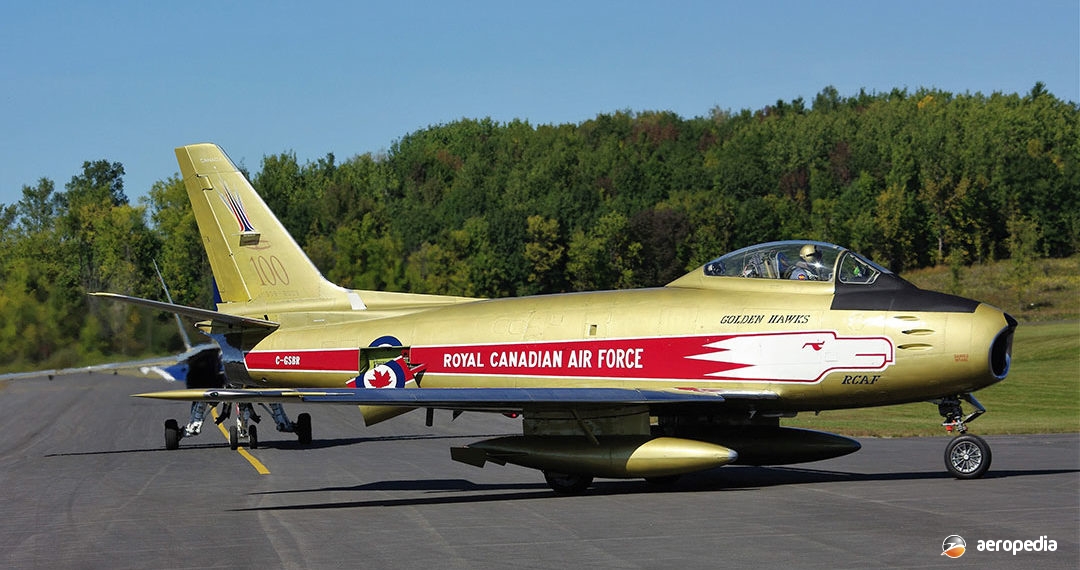Photograph:
Canadair CL-13B Sabre C-GSBR of the ‘Golden Hawks‘ display team at Gatineau, Quebec, Canada in September 2009 (David C Eyre)
Country of origin:
Canada
Description:
Single-seat fighter and fighter bomber
Power Plant:
One 7,272 lbst Avro Canada Orenda 14 axial flow turbojet with two-stage turbine
Specifications:
- Wingspan: 11.31 m (37 ft 1½ in)
- Length: 11.43 m (37 ft 6 in)
- Height: 4.5 m (14 ft 9 in)
- Wing area: 29.11 m² (313.37 sq ft)
- Max speed at sea level: 1,142 km/h (710 mph)
- Max speed at 3,048 m (10,000 ft): 1,094 km/h (680 mph)
- Max speed at 10,973 m (36,000 ft): 998 km/h (620 mph)
- Initial rate of climb: 3,597 m (11,800 ft/min)
- Time to 12,192 m (40,000 ft): 6 mins
- Tactical radius clean: 584 km (363 miles)
- Max range with 1,514 litres (333 Imp gals) in external tanks: 2,567 km (1,595 miles)
- Empty weight: 4,904 kg (10,811 lb)
- Loaded weight: 7,300 kg (16,094 lb)
- Max loaded weight: 7,988 kg (17,611 lb)
Armament:
Six 12.7 mm (0.5 in) Colt Browning machine guns; up to 1,814 kg (4,000 lb) of bombs and rockets on underwing stations; or long-range fuel tanks
History:
The licence-built Canadair CL-13 Sabre was just one of a number of variants of the popular North American F-86 Sabre series. Known as the CL-13 it was produced in a number of variants, the Mk 1 prototype (RCAF serial 19101) flying for the first time on 9 August 1950 and being an F-86A-5 assembled from components supplied from the US. The Mk 2 was equivalent to the F-86E fitted with a General Electric J47-GE-13 engine and 350 were delivered, three being supplied to the RAF in September 1952, later being returned to Canada when the Mk 4 became available.
The Mk 3 prototype was a Canadian-assembled airframe fitted with a 6,000 lbst Avro Canada Orenda 3 engine and had minor structural changes to take the new engine.
The Mk 4 was the production model for Britain’s Royal Air Force and was similar to the Mk 2 apart from compass, pressurisation control, canopy release and minor details. One served as a flight test bed for the 6,810 lbst Bristol Siddeley Orpheus BOr 12 turbojet.
The Mk 5 was the first Canadian-built model with the 6,355 lbst Avro Canada Orenda 10 engine for the RCAF. It was also supplied to the German Luftwaffe in 1957. The Mk 6, which was powered by a 7,275 lbst Avro Canada Orenda 14 engine, was first flown on 2 November 1954. Some 390 examples were built for Canada, six for the Colombian Air Force, 34 for South Africa and 225 for the German Luftwaffe. Pakistan eventually received 90 ex-German aircraft through a Swiss company which was said to be selling them to Iran.
Further variants were the CL-13C, CL-13E, CL-13G, CL-13H and CL-13J, the latter having a simplified Bristol afterburner for improved climb and acceleration. Canadair built a total of 1,815 Sabres, the last being delivered from the assembly line at Saint Laurence, Montreal. Deliveries were made to Canada, Germany, South Africa, Colombia, the United States, Greece, Italy, Turkey and Yugoslavia.
Late model Canadian-built Sabres were used by the RCAF and RAF in Europe during the Cold War, with Canada providing 12 squadrons for the Northern European NATO fighter force during the 1950s. Two squadrons were kept on a 5 minute and 15 minute alert status with fully-armed aircraft and live gunnery practice was regularly carried out in Sardinia, an island in the Mediterranean Sea. Intercepts and mock combats were also regularly carried out.
Following the withdrawal of the Sabre from military service around the world examples have come into private hands. The Canadian Sabre 6 was for a period operated in the 1990s by Corporate Jets Inc of Scottsdale, Arizona and operated by the Royal Netherlands Air Force Base at Leeuwarden for target towing. Two were registered as N30CJ and N50CJ and were ex-SAAF aircraft. Others operated have included Australian, Canadian and American aircraft.
One Canadian-built CL-13B Sabre 6 which served with the South African Air Force made its way to this part of the world. This aircraft (serial 383 with the c/n 1492) was operated from Lanseria by the SAAF and was given to the Kempton Park Technical College for training purposes but was instead placed on a ship and delivered to New Zealand where it was noted at Ardmore in March 2008. By August of that year it had been shipped to Panama Jacks at Jandakot, WA where it was placed in storage. It was expected to be rebuilt at some stage in the future but it is believed to have been obtained by a private collector for a museum..

